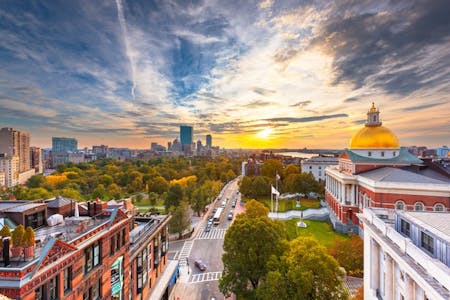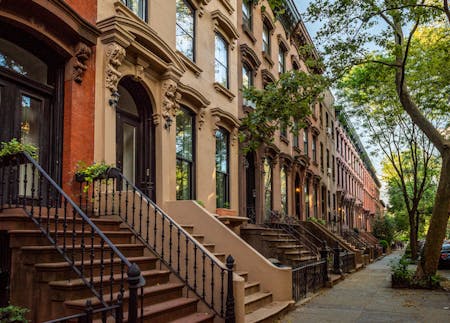Most Expensive Neighborhoods in Boston - 2025 Guide
By Sean Creamer on January 02, 2025
As some Boston homeowners are considering a move to the suburbs, there hasn’t been a better opportunity to buy your place in some of the most expensive Boston neighborhoods.
People moving to relocate are looking to sell their city properties, so if you’re in a position to buy your first home or are investing in a second home, Boston’s storied properties downtown are finally becoming available.

From the North End’s historic homes and tight cobblestone streets to the Seaport District’s newly developed oceanfront playground, Boston’s distinctive neighborhoods appeal to homeowners and investors from all walks of life.
Most expensive neighborhoods in Boston
- Beacon Hill
- Seaport District
- Back Bay
- Fenway / Kenmore
- South End
- North End
- West End
Beacon Hill
Beacon Hill is one of Boston’s original neighborhoods, and prospective homeowners can expect historic real estate dating back to the city’s colonial roots. For example, buyers can visit Acorn Street, where historic Federal-style row houses on cobblestone streets are adorned with laid-brick sidewalks glow under antique gas lamps.
The Shawmut Peninsula hosted several large hills, one of which served as a foundation for a large Beacon to warn residents of impending raids on the fledgling city. The need for land to accommodate a growing number of residents drove developers to remove the beacon and flatten the hill to clear room for homes on the North and South Slope, as well as the Flat Top of Beacon Hill.
The Flat Top and South Slope is where home buyers or investors seeking luxury properties in Beacon Hill can expect historical living within a cobblestone’s throw of Downtown in one of the best Boston neighborhoods. The North Slope is home to young professionals and the Museum of African American History, which details how back in the 1700s, African-Americans established a community that built schools, libraries, churches, and markets on the North Slope.
Browse Listings in Beacon Hill
Seaport District
The development of the Seaport is one of the newest land reclamation efforts in the storied history of building up the Shawmut Peninsula. South of Downtown, the Seaport is home to over 75 restaurants, a myriad of shopping boutiques, and numerous art galleries. After the completion of the Big Dig project, which diverted the I-93 out of downtown Boston, the Seaport was finally accessible. Commercial real estate developers immediately began constructing the Boston Convention and Exhibition Center, the Seaport World Trade Center, improving the Boston Fan Piers, and building over 1,000 residential condo units.
Once the Big Dig came to a close, developers turned the parking lots in the area into the Fan Piers, complete with a waterfront park and four commercial towers housing tech start-ups and incubators for new businesses. Considering the neighborhood’s penchant for restaurants and bars serving these office workers, young professionals will find Seaport’s proximity to Downtown and the region’s vibrant nightlife appealing as a district to rent an apartment or own a condo in
Prospective buyers taking a day to explore the luxury real estate in Seaport should make time to check out the Boston Tea Party Museum and the Institute of Contemporary Art.
Browse Listings in Seaport District
PREVU SMART TIP
Did you know you can receive a commission rebate from your broker? Buying with Prevu you’ll pocket a portion of the commission paid to your buyer’s broker at closing. On a $1 million home in Boston, you’d receive up to $10,000 cash back.
Learn about commission rebatesBack Bay
If you seek a historical neighborhood with spacious streets and proximity to major business centers, Back Bay’s rows of Victorian brownstones might fit your investing needs.
Back in the 1600s, when settlers first founded Boston, Back Bay was a tidal bay behind the Shawmut Peninsula, which serves as the foundation for Beacon Hill, The Seaport, and the West and North Ends. As the city grew, so did the need for space.
In the 1800s, after the disastrous industrial Cross Dam project drained the bay and exposed foul-smell fens and swamps. Savvy real estate developers struck gold. Wealthy Bostonians in the 1800s desired more space as serpentine streets crowded the North End and Beacon Hill neighborhoods, and developers filled the void, figuratively and literally. They filled the remainder of the bay, creating spacious real estate on well-planned, Alphabetically named streets and avenues. Today, prospective buyers perusing real estate in Back Bay will find America's largest and most well-preserved collection of Victorian row-style homes.
High street fashion boutiques and malls populate Newbury and Boylston street to the north, where Back Bay’s design mimes historical Parisian neighborhoods. Whereas, the southern border houses the High Spine comprising high rises such as the John Hancock Tower and the Prudential Center. Buyers can expect top-notch dining as the neighborhood hosts the Taste of Back Bay each year, where revelers sample dishes from 30 prominent restaurants.
Fenway / Kenmore
Home to the Boston Red Sox, the Fenway / Kenmore neighborhood borders Back Bay to the west, providing prospective buyers with solace away from the bustling of Boston. Outside of Fenway Park, this region of Boston is home to its namesake, the Fenway, a roadway intersecting the Back Bay Fens and the Muddy River, which both run through the neighborhood.
Beyond the meandering Muddy river, prospective homebuyers perusing through Fenway can also expect to find a variety of brick walk-ups, brownstone townhouses, and apartment buildings several stories high. Fenway / Kenmore is home to Northeastern University, Berklee School of Music, and Boston University, and buyers can expect a healthy population of college students hanging out at the bars and restaurants catering to their reveries.
Originally part of the neighboring town of Brookline, Boston annexed Fenway / Kenmore and developed large tracts of land to entice wealthy Bostonites nestled in Back Bay and Beacon Hill. The street names in West Fenway are in alphabetical order, starting with Ipswich since Back Bay ends with Hereford Street. While developers aimed to attract wealthy homeowners to the region, by 1907, over 20 educational institutions sprung up around the Fenway.
Beyond watching the Red Sox smash home runs and smelling the roses in the Back Bay Fens, homeowners in the Fenway can take in the arts at the Isabella Stewart Gardner Museum or Museum of Fine Arts.
Browse Listings in Fenway / Kenmore
South End
If you’re seeking eclectic life in the heart of Boston’s art and culture scene, then buyers should take the time to explore the restaurants and music halls of the South End. Bordered by Back Bay to the north, the South End is home to a variety of restored Victorian-era and Greek Revivalist homes, and prospective homebuyers can find English-style Square residences on the outskirts of the neighborhood.
From corner side pubs to family-style bistro dining, there are plenty of outlets where homeowners can relax after a day in Downtown, which is minutes away to the East. Historically, the majority of the South End comprised of tidal marshes, but as the need for real estate grew, the developers filled in the Boston Neck to make space for new housing.
Beginning in the 1880s, the South End was known as a neighborhood for immigrants, providing housing to Greek, Lebanese, African-American, and Jewish families. Starting in the early 1900s and lasting until the 1970s, the South End was known as a mecca for jazz musicians. While many of the jazz venues closed their doors, music fans can still find folks still bending the blues at Wally’s Paradise.
Beyond music, homebuyers eyeing the South End will find a neighborhood known for its arts scene and a vibrant LGBT community. With roots going back to the 1940s when single unit apartments provided housing for unmarried men, the LGBT community grew over the years, bringing arts, bars, and an annual parade to this colorful neighborhood.
North End
Founded in the 1620s, the North End of Boston is the oldest neighborhood in the city. This historic neighborhood is home to a Byzantium-like maze of streets, adorned with brick-faced buildings calling back to Boston's colonial roots. Prospective homeowners can take a walk through American history on the Freedom Trail, which contains famous buildings from the revolutionary war like the Paul Revere House and the Old North Church.
Despite being one of the smallest neighborhoods in Boston, the North End is home to over 100 establishments, from numerous restaurants to the Boston Public Library. The North End is known for its deep-rooted Italian culture, as many immigrants settled here in the 1890s. Buyers can expect an array of Italian cuisines and cafes to explore as they are checking out multi-million dollar condos on the waterfront or perusing through the multi-story walk-ups nestled into the neighborhood.
Homeowners in the North End can expect summers full of Italian feast processions celebrating the saints, from the Santa Maria Di Anzano Procession to the Saint Padre Pio Procession and more. These feasts began in the early 1900s when local Italian families came together, but have since grown to draw in visitors from around the world.
West End
Homebuyers looking for high-rise residential condos with waterfront property will find their dream real estate in the West End of Boston. Like many neighborhoods borne from the original 1600s settlement, developers built up the West End with gravel and soil to create space for more residents as the city grew.
Over time, the West End began to resemble Beacon Hill and the North End as the region boasted serpentine streets and colonial-era brick walk-ups. While developers razed many historical homes to create luxury condos, historically-minded homebuyers will still find colonial mansions such as the Harrison Gray Otis House nestled in this redeveloped neighborhood.
The West End welcomed immigrants to America over several centuries. By the 1950s, wealthy real estate developers demolished the original buildings and streets in favor of broad avenues and high rise residential units, to the chagrin of many working-class Bostonites. Today, condo buyers will find chances to spend time along the Charles River waterfront at Lederman Park and explore the Museum of Science sitting atop the Charles River Dam.
Most Expensive Boston Neighborhoods
- Beacon Hill - $3,181,088
- Seaport District - $2,831,060
- Back Bay - $2,541,007
- Fenway / Kenmore - $2,116,283
- South End - $1,725,633
- North End - $1,431, 819
- West End - $725,959
Interested in buying a home in your favorite Boston neighborhood? Browse listings and see how much you can save with Prevu’s Smart Buyer commission rebate.











